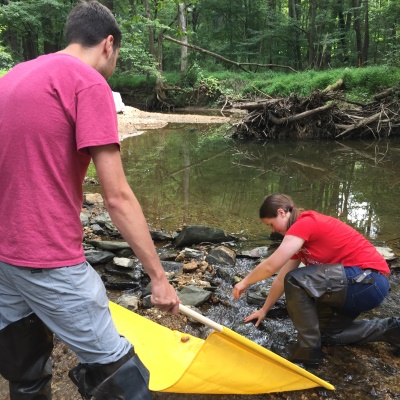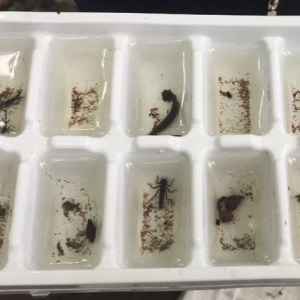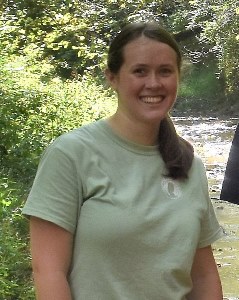Heather Black, Chesapeake Conservation Corps Volunteer at the Izaak Walton League

The first time I ever ventured into a stream to do water quality monitoring was more than two years ago. I was amazed that I was even there. I have always had a love for the outdoors, but I had also had a slight dislike and fear of bugs. The thought of spending part of the day searching for them baffled me. Yet there I was, ankle deep in the middle of Cabin Branch, rubbing rocks and looking for the very things I disliked.
Why was I there? I wanted to develop a better understanding of where my drinking water came from and learn about the impacts everyday activities can have on the health of streams. Many American’s might not realize this, but almost two-thirds of the water we use throughout the day – whether for drinking, cleaning, or recreation – comes from rivers and streams. For me, that’s the Potomac River, which Cabin Branch eventually drains into.
The health of small streams such as Cabin Branch – and there are many such streams in the Potomac River watershed – have a large impact on the rivers into which they flow. That’s why it is important to test water quality in every stream. The United States has more than 3.5 million miles of rivers and streams – a number that would be impossible to monitor regularly without the help of citizen scientists like you and me.
But what does water quality monitoring mean? And how do you get involved?
 There are three parts to monitoring water quality in local streams: physical, chemical, and biological monitoring. Depending on the amount of time you have available and how in-depth you would like to get, you can do one, two, or all three:
There are three parts to monitoring water quality in local streams: physical, chemical, and biological monitoring. Depending on the amount of time you have available and how in-depth you would like to get, you can do one, two, or all three:
- Physical monitoring is the easiest aspect of water quality monitoring and might be something you’re doing already! The focus is on sensory observations, including water appearance, odor, algae amount, and stream bank composition. You can also report on the stream width, depth, and flow. Essentially you want to find the things that make that stream unique.
- Chemical monitoring gives you a snapshot of the current condition of the stream. You will find out about dissolved oxygen, pH, chloride, phosphate, nitrate, and turbidity levels in the stream as well as the current water temperature.
- Biological monitoring involves sampling the macroinvertebrates (bugs) within a section of the stream and provides a more detailed measurement of overall stream health. Every macroinvertebrate has a different sensitivity level to pollution and their numbers will vary depending on the health of the stream.
A fun way to start getting to know your local streams is through Stream Selfie. Take a picture of yourself, family, or friends at a local stream and let us know about it. If you are ready to jump into stream monitoring, the Izaak Walton League offers in-person trainings and online tools to help you get started.
 I am proud that I was able to move past my dislike of bugs and develop a love for water quality monitoring. I never could have imaged two-and-a-half years ago that I would be pursuing a career in clean water. Yet here I am today, working to encourage others to try something new too!
I am proud that I was able to move past my dislike of bugs and develop a love for water quality monitoring. I never could have imaged two-and-a-half years ago that I would be pursuing a career in clean water. Yet here I am today, working to encourage others to try something new too!
I invite you to visit your local stream.
IWLA Chesapeake Conservation Corps volunteer Heather Black's favorite macroinvertebrate is the mayfly because it is very diverse.